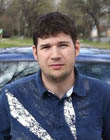|
|
This topic comprises 2 pages: 1 2
|
|
Author
|
Topic: Strong Ultra 80 vs Cinemeccanica ZX 8000
|
Ari Nordström
Master Film Handler

Posts: 283
From: Göteborg, Sweden
Registered: Jan 2000
|
 posted 01-02-2005 05:47 PM
posted 01-02-2005 05:47 PM




Hello everyone,
We're going to throw out our old Cinemeccanica Zenith X4000 lamphouses after some 28 years of service, and are considering the Strong Ultra 80 to replace them. However, our usual tech also happens to be a Cinemeccanica rep and would like us to consider their ZX 8000 house.
Now, a search on the forums gave the Ultra 80 some very nice reviews but I couldn't find anything on the Cinemeccanica house so I'd very much appreciate any information you might have on both of these houses. And also, I'm assuming that at 4.5 kW, the Ultra 80 wouldn't be too harmful to 35 mm prints. Is this safe to do?
We show both 35 and 70 mm, today with 4 kW standing OSRAM bulbs and IREM rectifiers. The projectors are Zeiss Favorit70s with water-cooled gates. Our screen is fairly large (about 15 meters) and the old houses haven't really been up to the task. The IREMs we'd like to keep, though, if at all possible.
Best regards,
/Ari
| IP: Logged
|
|
|
|
|
|
|
|
|
|
|
|
John Pytlak
Film God

Posts: 9987
From: Rochester, NY 14650-1922
Registered: Jan 2000
|
 posted 01-03-2005 09:53 AM
posted 01-03-2005 09:53 AM





A heat filter is certainly "essential" to protect B&W silver image prints from heat damage with larger lamps, and is "recommended" for reducing "focus flutter" with any print:
Heat Damage Part 1
Heat Damage Part 2
quote:
New theater construction emphasizes "wall to wall" images on screens that often exceed fifty feet in width. Only five years ago, the average xenon bulb power was 2000 watts. Today, power levels of 4000 watts are common, with some theaters using as many as 7000 watts to project 35 mm film onto 80 foot screens.
Focusing all that power through a postage-stamp size piece of film can cause problems ranging from image flutter and focus drift to permanent print damage like blistering, scorching, fading and dye migration. In our years of studying the effects of excessive heat on film, Kodak has identified three major areas of concern: improper or non- existent use of heat filters,
excessive bulb current, and maladjustment of bulb focus causing a "hot spot."
Heat Filters
Use of efficient heat filters is recommended for all projectors and is mandatory for any lamp larger than 2000 watts. Aluminized, silver, or rhodium surfaced reflectors without heat filtration are intended only for specialized applications and should not be used for theaters. Xenon bulbs emit a large amount of their energy in the infrared portion of the spectrum. Excess infrared energy absorbed by the film is a major source of heat damage, especially with blackand-white prints (silver grains absorb more infrared energy than color dyes).
An efficient heat filter removes most of the damaging infrared energy produced by the lamp. Most heat filters rely on diachronic coatings on the reflector, making it reflect visible light and absorb infrared energy. Consoles with vertically-mounted bulbs usually use a flat diachronic mirror set at a 45-
degree angle, which reflects visible light to the aperture and transmits the unwanted infrared energy to a heat sink.
The efficiency of heat filters varies among manufacturers, and is affected by the age and condition of the dichroic coatings. When purchasing new lamphouses, compare the efficiency of the heat filter system in rejecting unwanted ultraviolet and infrared energy. Always keep the surface of the mirror and heat filters clean and dust free, using the cleaning procedures
recommended by the manufacturer. Dichroic coatings are very fragile and easily damaged if cleaned improperly. Heat filters with obviously worn, pitted, or damaged dichroic coatings should be replaced. Do not remove heat filters or use reflectors with no heat protection, even to get a bit more light on the screen. You'll get a bit more light-and a lot more heat damage
| IP: Logged
|
|
|
|
|
|
|
|
|
|
|
|
|
|
|
|
|
|
|
|
All times are Central (GMT -6:00)
|
This topic comprises 2 pages: 1 2
|
Powered by Infopop Corporation
UBB.classicTM
6.3.1.2
The Film-Tech Forums are designed for various members related to the cinema industry to express their opinions, viewpoints and testimonials on various products, services and events based upon speculation, personal knowledge and factual information through use, therefore all views represented here allow no liability upon the publishers of this web site and the owners of said views assume no liability for any ill will resulting from these postings. The posts made here are for educational as well as entertainment purposes and as such anyone viewing this portion of the website must accept these views as statements of the author of that opinion
and agrees to release the authors from any and all liability.
|

 Home
Home
 Products
Products
 Store
Store
 Forum
Forum
 Warehouse
Warehouse
 Contact Us
Contact Us




 Printer-friendly view of this topic
Printer-friendly view of this topic









![[Frown]](frown.gif)



![[thumbsup]](graemlins/thumbsup.gif)


![[Smile]](smile.gif)



